AUDI A5 COUPE 2011 Owners Manual
Manufacturer: AUDI, Model Year: 2011, Model line: A5 COUPE, Model: AUDI A5 COUPE 2011Pages: 362, PDF Size: 84.88 MB
Page 151 of 362
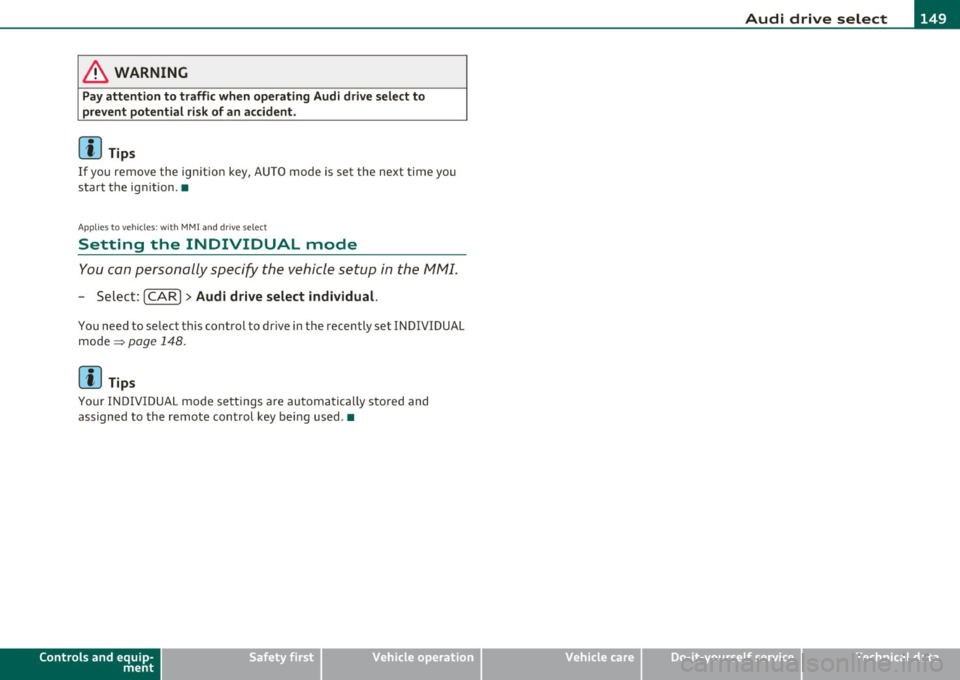
________________________________________________ A_u_ d_i_ d_ r_iv _ e_ s_e _ le_ c_t __ _
& WARNING
Pay attention to traffic when operating Audi drive s elect to
prevent potential risk of an a ccident.
[I] Tips
If you remove the ign it ion key, A UTO mode is set the next time you
start the ign it ion. •
Applies to v ehicles: w it h MM! and driv e se lect
Setting the INDIVIDUAL mode
You con personally s pecify th e vehicle setup in th e MM I.
- Select : [CA R]> Audi drive select individual.
You need to se lect this control to d rive in the recently set INDIVIDUAL
mode ~ page 14 8.
[I] Tips
Your I NDIVID UA L mo de se ttings a re automa tic ally sto red and
assigned to the remote con trol key being used .•
Controls and equip
ment Safety first
Vehicle care Technical data
Page 152 of 362
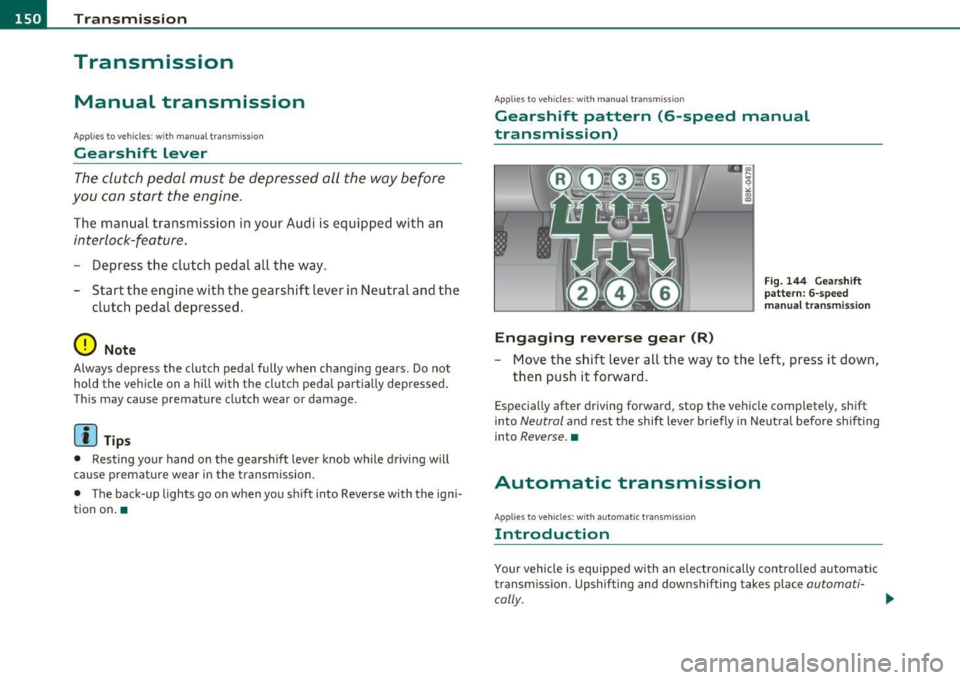
ffl..__T_ r _a_ n_s _ m_ i_ s _s_ i_ o _ n _________________________________________________ _
Transmission
Manual transmission
Applies to vehicles: with manua l transm ission
Gearshift lever
The clutch pedal must be depressed all the way before
you can start the engine.
The manual transmission in your Audi is equipped with an
interlock-feature.
- Depress the clutch pedal all the way .
- Start the eng ine with the gears hift lever in Neutral and the
clutch peda l depressed.
0 Note
Always depress the clutch pedal fully when changing gears. Do not
hold t he veh icle on a hill with the clutch peda l part ia ll y depressed.
T hi s may cause premature clutch wear or damage.
[I) Tips
• Resting your hand on the gearshift lever knob while driving will
cause premature wear in the transm ission.
• The back -up lights go on when you sh ift into Reverse with the igni
tion on. •
Applies to veh icles: with manual transm ission
Gearshift pattern (6-speed manual
transmission)
Engaging reverse gear (R)
Fig. 144 Gearshift
p att ern: 6-sp eed
manu al trans missio n
- Move the shift lever all the way to the left, press it down,
then push it forward.
Especially after driving forward, stop the vehicle completely, shift
into
Neutral and rest the shift leve r briefly in Neutral before s hifting
into
Reverse .•
Automatic transmission
Applies to veh icles: with automatic tra nsm iss ion
Introduction
Your vehicle is equipped wi th an e lectron ically contro lled automatic
transmiss ion . Upshifting and downshifting takes place
automati-
cally . .,,.
Page 153 of 362
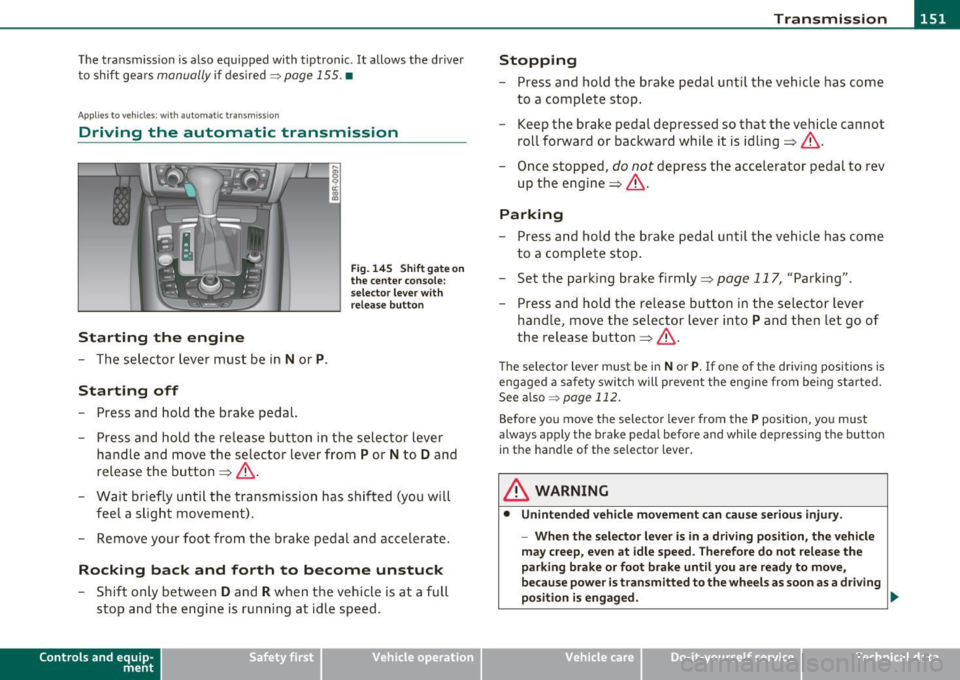
Transmission -_______________ ___.
The transmiss ion is also equipped with tiptronic . It allows the driver
t o shift gea rs
manually if desired ~ page 155 . •
Applies to vehicles: wit h au tom atic tr ansm ission
Driving the automatic transmission
Starting the engine
- The se lector lever must be in N or P.
Starting off
- Press and hold the brake pedal.
Fi g. 14 5 Sh ift gat e on
the center con sole:
s e le ctor le ve r with
r e lea se b utton
- Press and ho ld the release button in the sel ector lever
handle a nd move the selector lever from
P or N to D and
release the but ton => &, .
- Wait briefly unti l the tran smission has shif ted (you will
feel a slight movement).
- Remove your foot from t he brake pedal and accelerate.
Rocking back and forth to become unstuck
- Shift o nly betwee n D and R when the ve hicle is at a full
stop and the engine is running at idle speed.
Con tro ls a nd e quip
m en t Vehicle
OP-eration
Stopping
-Press and hold the brake peda l unti l th e vehicle has come
to a complete stop.
- Keep the brake pedal depressed so that the veh icle can not
roll forward or backward while it is idling => &, .
- Once stopped,
do not depress t he accelerator pedal to rev
up the engine=> &,.
Parking
-Press and ho ld the brake peda l unt il the veh icle has come
to a compl ete stop .
- Set the parking brake firmly=>
page 117, "Parking" .
- Press and hold the release button in the selector lever
handle, move the selector lever into
P and then let go of
the release button=>&, .
The selector lever must be in Nor P. If one of the dr iv ing positions is
engaged a safety swi tch will prevent the eng ine from be ing started.
See also ~
page 112.
Before you move the selecto r lever from the P position, yo u must
always apply the brake pedal befo re and while depressing the button
in the handle of the selector lever .
& WARNING
• Unintended vehicle movement can c ause seriou s injur y.
- When th e selector l ever is in a driv ing po sition, the vehicl e
m ay creep , even at idle speed. Therefore do not relea se the
parking bra ke or foot brak e until you are ready to mov e,
because power is t ransmitted to the wheel s as soon as a dri ving
po sition i s engaged . ._
Vehicle care Do-it-yourselt service iTechnical data
Page 154 of 362

-Transmission •m ___________________ _
& WARNING (continued)
- Do not accelerate while selecting a driving position . At this
time the engine must be at idle speed so that undue stre ss is
not placed on the clutches in the transmission.
- Remember : Even when stopped briefly with the automatic
transmission in D,S or R , engine power is being transmitted to
the wheels . Your vehicle could " creep" forward or backward.
When stopped, keep the brake pedal fully depressed and use
the parking brake if necessary to keep the vehicle from rolling .
• If the selector lever is unintentionally mo ved into N while you
are driving, take your foot off the accelerator p edal and wait for
the engine to return to idle speed before selecting a driv ing posi
tion .
• Never shift into R or P when the vehicle is in motion.
• Never get out of the dr iver's seat when the engine is running.
• If you must get out of the vehicle, move the selector lever
secure ly into the P position and app ly the parking brake firmly.
• If the engine must remain running, never have any driving
position engaged when checking under the hood. Make sure the
selector lever has securely engaged and is locked in P with the parking brake firmly set=>
page 267, "Engine compartment ".
Otherwi se, any increase in engine speed may set the vehicle in
motion, even with the parking brake applied. •
Applie s to v ehicl es: wi th auto matic tra nsm issi on
Selector Lever positions
This section descri bes the se lector lever positions and
driving r ang es .
Fig. 146 Dis play in
the in strument clu ster :
selecto r leve r
in posi
ti on P
Th e sele cto r lever posi tio n engaged appears nex t to the se lec tor lever
as well as in the i nstr ument clus ter disp lay .
P -Park
In this selector lever position th e transmission is mechan ically
lo ck ed. En gage
P only whe n the ve hicl e is completely stopped=> &
in "Driving the automatic t ransm ission" on page 151.
To shift in or o ut o f p osit ion P, yo u must first press and hold the bra ke
peda l
and then press t he release button in t he selecto r leve r handle
w hil e moving the selector lever to or from
P. You can shif t out of this
position on ly w it h t he i gni tion o n.
R -Reverse
Th e transm ission will automa tica lly select the lowest gear ratio when
you sh ift into reverse.
Sele ct
R o nl y when t he ve hicle is at a full stop a nd t he e ng ine is
ru nning at idle speed=>
& in "Driving th e automat ic transm issio n"
on
page 151 . ...
Page 155 of 362

Transmission Ill _______________ ___.
Before you move the selector lever to R, press both the button in the
hand le of the se lec tor lever
and the brake peda l at the same t ime .
When the ignition is on, the backup lights illuminate when the
selector lever is moved into
R .
N -Neutral
The transmission is in neutral in this position. Sh ift to th is position
for standing with the brakes applied~
page 153.
When the vehicle is stationary or at speeds below 3 mph (5 km/h) ,
you must always apply the footbrake before and wh ile moving the
lever out of
N .
D -Normal po sition for driving forw ard
Posit ion Dis for normal city and highway driving. It ranges from zero
to top speed and al l gears shift automatically, depending on engine
load, driving speed and automatically selected shift programs .
When the vehicle is stat ionary or at speeds below 3 mph (5 km/h),
you must always apply the foot brake before and while moving the lever to
D out o f N.
In certa in circumstances it may be advantageous to temporarily
switch to the manual shift program to manually select gear rat ios to
match specific driving conditions~
page 155.
S -Sport position *
Select this position for sportie r performance. In this position, the
transm ission will not upsh ift as soon, allowing the vehicle to use the
increased power available at higher eng ine speeds to ach ieve livelier
acceleration .
When the vehicle is stat ionary o r at speeds be low 3 mph (5 km/h),
you must always apply the foot brake before and while moving the lever to
S out of N .
Con tro ls a nd e quip
m en t Vehicle
OP-eration
& WARNING
Read and fo llow all WARNING S~ & in "Dri ving th e a utomatic
tran smi ssion" on
pa ge 151 .
0 Note
Coast ing downh ill with the transmission in N and the engine not
running will result in damage to the automatic transmission and
possibly the cata lytic converter. •
Applies to vehicle s: wi th auto mat ic tra nsmi ss ion
Automatic Shift Lock (ASL)
The Automatic Shift Lock safeguards you against acci
dentally shifting into a forward or the reverse gear and
causing the vehicle to move unintentionally .
Fig. 14 7 S hift gate:
s e le ctor lever lock pos i
tio ns and in te rlo ck
bu tton hi ghligh ted
The selector lever lock is released as fo llows:
- Turn the ignit ion on.
- Step on the brake pedal.
At the same time press and hold
the interlock button on the s ide of the gear selector knob
=> fig . 147 with your thumb until you have moved the
selector lever to the desired position. .,
Vehicle care Do-it-yourselt service iTechnical data
Page 156 of 362
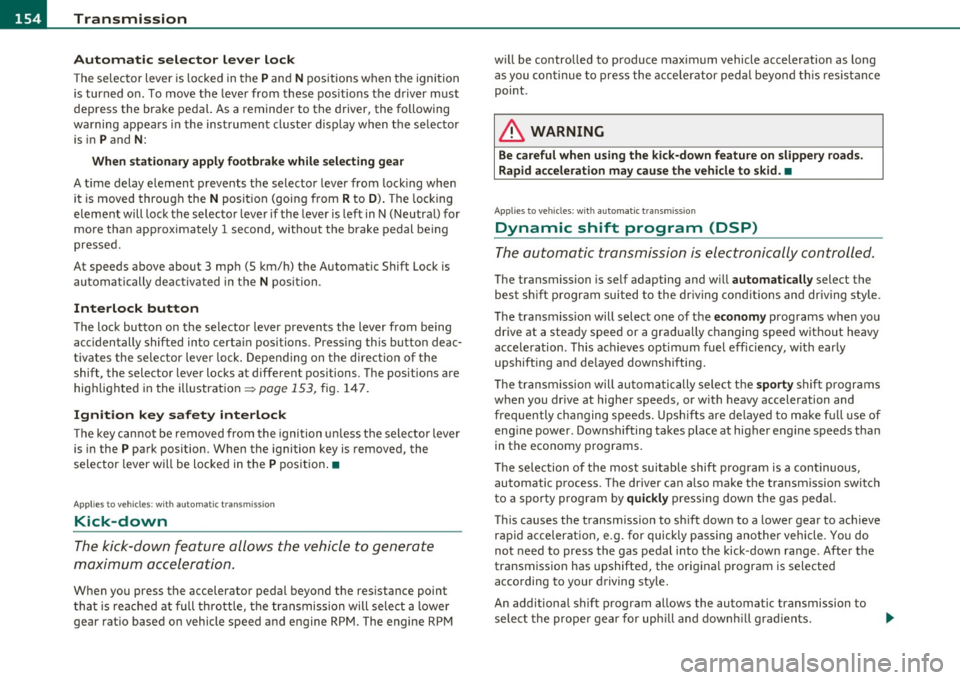
1111 ...... __ T _r_ a_ n _ s_ m __ is_ s_io _ n _____________________________________________________ _
Automatic selector lever lock
The selector lever is locked in the P and N positions when the ignition
is turned on . To move the lever from these positions the driver must
depress the brake pedal. As a reminder to the driver, the following
warning appears in the instrument cluster display when the selector
is in
P and N:
When stationary apply footbrake while selecting gear
A time delay element prevents the selector lever from locking when
it is moved through the
N position (going from R to D). The locking
element will lock the selector lever if the lever is left in N (Neutral) for
more than approximately 1 second, without the brake pedal being
pressed .
At speeds above about 3 mph (5 km/h) the Automatic Shift Lock is
automatically deactivated in the
N position.
Interlock button
The lock button on the selector lever prevents the lever from being
accidentally shifted into ce rtain positions. Pressing this button deac
tivates the selector lever lock. Depending on the direction of the
shift, the selector lever locks at different positions . The positions are
highlighted in the illustration ~
page 153, fig. 147.
Ignition key safety interlock
The key cannot be removed from the ignition unless the selector lever
is in the
P park position . When the ignition key is removed, the
selector lever will be locked in the
P position. •
Applies to vehicle s: with au toma tic tr ansm is si on
Kick-down
The kick-down feature allows the vehicle to generate
maximum acceleration.
When you press the accelerator pedal beyond the resistance point
that is reached at full throttle, the transmission will select a lower
gear ratio based on vehicle speed and engine RPM . The engine RPM will be controlled to produce maximum vehicle acceleration as
long
as you continue to press the accelerator pedal beyond this resistance
point .
& WARNING
Be careful when using the kick-down feature on slippery roads.
Rapid acceleration may cause the vehicle to skid. •
Applies to ve hicles : with automatic t ransm iss ion
Dynamic shift program (DSP)
The automatic transmission is electronically controlled.
The transmission is self adapting and will automatically select the
best shift program suited to the driving conditions and driving style .
The transmission will select one of the
economy programs when you
drive at a steady speed or a gradually changing speed without heavy
acceleration . This achieves optimum fuel efficiency, with early
upshifting and delayed downshifting.
The transmission will automatically select the
sporty shift programs
when you drive at higher speeds, or with heavy acceleration and
frequently changing speeds. Upshifts are delayed to make full use of
engine power . Downshifting takes place at higher engine speeds than
in the economy programs.
The selection of the most suitable shift program is a continuous,
automatic process . The driver can also make the transmission switch
to a sporty program by
quickly pressing down the gas pedal.
This causes the transmission to shift down to a lower gear to achieve rapid acceleration, e.g. for quickly passing another vehicle. You do
not need to press the gas pedal into the kick -down range. After the
transmission has upshifted, the original program is selected
according to your driving style.
An additional shift program allows the automatic transmission to
select the proper gear for uphill and downhill gradients.
Page 157 of 362
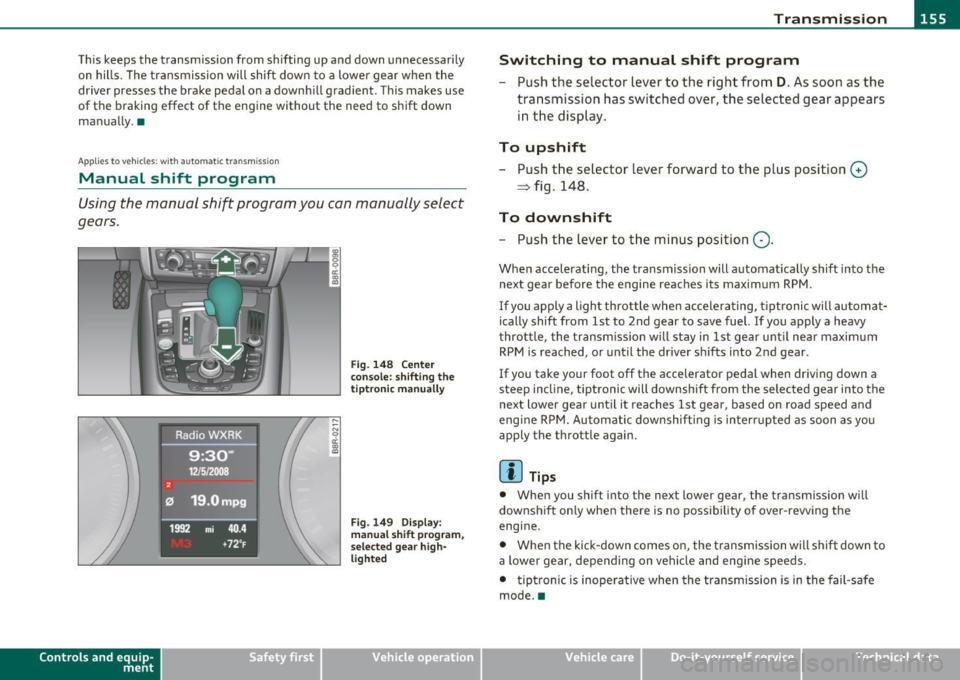
Transmission Ill _______________ ___.
This keeps the transmission from shifting up and down unnecessarily
on hills . Th e transmission will shift down to a lower gear when the
driver presses the brake pedal on a downhill gradient . This makes use
of the braking effect of the engine without the need to shift down
manually .•
Ap plies to vehicl es : w ith au tom atic transm iss io n
Manual shift program
Using the manual shift program you can manually select
gears .
Contro ls a nd e quip
m en t Fig. 148 Center
console: shifting the
tiptronic manually
Fig. 149 Display :
manual shift program,
selected gear high
lig hted
Vehicle OP-eration
Switching to manual shift program
-Push the selector lever to the right from D. As soon as the
transmission has switched over, the selected gear appears
in the display.
To upshift
- Push the selector lever forward to the plus position 0
~ fig. 148.
To downshift
- Push the lever to the minus position Q.
When accelerating, the transmission will automat ica lly shift into the
next gear before the engine reaches its maximum RPM.
If you apply a light throttle when accelerating, tiptr onic will automat
ically shift from 1st to 2nd gear to save fuel. If you apply a heavy
throttle, the transmission will stay in 1st gear until near maximum
RPM is reached, or until the dr iver sh ifts i nto 2nd gear.
If you take your foot off the accelerator pedal when driving down a
steep incline , tiptronic will downshift from the selected gear into the
next lower gear until it reaches 1st gear , based on road speed and
eng ine RPM. Automatic downshifting is interrupted as soon as you
apply the throttle again.
[ i ] Tips
• When you shif t into the next lower gear, the transmission will
downshift on ly when there is no possibility of over-revving the
engine.
• When the kick-down comes on, the transmission will shift down to
a lower gear, depending on vehicle and engine speeds.
• tiptronic is inoperative when the transmission is in the fail-safe
mode. •
Vehicle care Do-it-yourselt service iTechnical data
Page 158 of 362

1111..__T_ r_a _ n_ s_m_ i _s_ s_ io_ n _____________________________________________________ _
Applie s to veh icles : wi th tiptro nic steer ing whe el
Steering wheel with tiptronic
The shift buttons on the steering wheel allow the driver to
shift gears manually.
F ig. 15 0 Steering
wh eel: Sh ift butt ons
- To downshift, touch the button on the left Q.
- To upshift , touch the button on the right G) .
The shift but tons are a ct ivated when the selec to r l ever is in D, Sor in
the manual shift program (t iptronic).
Of course, you can continue to use the manual shift program with the
selector lever on the cente r console. •
Applies to veh icles: w ith automat ic transm ission
Automatic transmission malfunction l
In the event of a system malfunction, the automatic transmission
switches to emergency operation mode.
Gearbox malfunction : you can continue driving
You can continue to dr ive the vehicle . See an authorized Audi dealer
or other qualifie d workshop at the next opportu nity.
Gearbo x malfunction : you can continue driving (limited
functionality)
T he re is a ser ious system malfunc tion:
• The program sh if ts only into certa in gea rs .
• T he engine may stall.
• It is not possible to restart the engine if it has been switched off.
• Continuing to d rive cou ld res ult in subseq uent damage .
0 Note
If the transmission switches to fail-safe mode, you sho uld take the
vehicle to an authorized Audi dea lership as soon as poss ible to have
t he con ditio n corre cted. •
Applies t o vehi cles: with au to m ati c transm iss ion
Emergency release of the selector lever
I f the vehi cle's power supply fails, the selector lever can
be released in an emergency.
Fig. 1 51 Removi ng
as htr ay in sert ..
Page 159 of 362
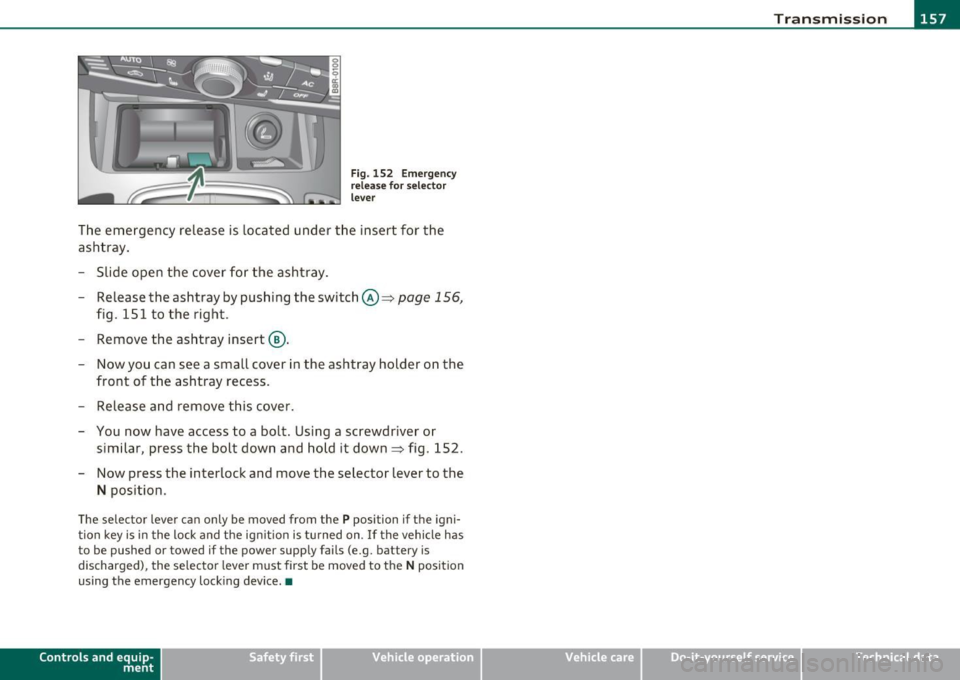
__________________________________________________ T_ ra_ n_s_ m __ is_s_ i_ o_ n _ ___.fflll
Fig. 152 Emergency
r elease for se lector
lever
The emergency release is located under the insert for the
ashtray .
- Slide open the cover for the ashtray .
- Release the ashtray by pushing the switch©=>
page 156,
fig. 151 to the right.
- Remove the ashtray insert @.
- Now you can see a small cover in the ashtray holder on the
front of the ashtray recess.
- Release and remove this cover.
- You now have access to a bolt. Using a screwdriver or similar, press the bolt down and hold it down=> fig. 152.
- Now press the interlock and move the selector lever to the
N position .
The selector lever can only be moved from the P position if the igni
tion key is in the lock and the ignit io n is tur ned on. If the vehicle has
to be pushed or towed if the power supply fails (e.g. battery is
discharged), the selector lever must first be moved to the
N position
using the emergency locking device .•
Con tro ls a nd e quip
m en t Vehicle
OP-eration Vehicle care Do-it-yourselt service iTechnical data
Page 160 of 362
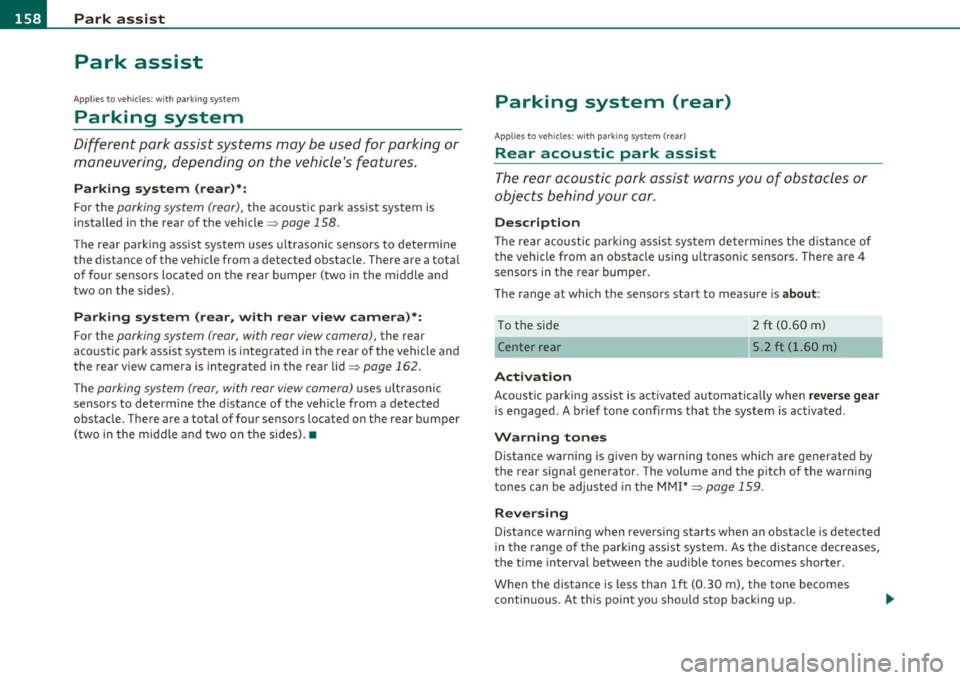
1111...._ __ P_a _ r_ k_ a_ s_ s_is _ t ____________________________________________________ _
Park assist
Applies to veh icles: w ith pa rk ing sys te m
Parking system
Different park assist systems may be used for parking or
maneuvering , depending on the vehicle's features .
Parking system (rear)*:
For the parking system (rear), th e acoust ic park assist system is
installed in the rear of the vehicle~
page 158.
The rear pa rk ing assist system uses ultrasonic sensors to determine
the distance of the vehicle from a detected obstacle. There are a tota l
o f f our sensors located on the rear bumper (two in the m iddle and
two on the sides) .
Parking system (rear, with rear view camera)*:
For the parking system (rear , with rear view camera), the rear
aco ust ic park assist sys tem is integra ted in the rear of the vehicle and
the rear view camera is integrated in the rear lid~
page 162.
The parking system (rear, with rear view camera) uses ultrasonic
sensors to determine the d istance of the vehicle from a detected
obstacle. There are a total of four sensors located on the rear bumper
(two in the m iddle a nd two on the sides). •
Parking system (rear)
Appli es to ve hicl es: w ith park ing syste m (rear)
Rear acoustic park assist
The rear acoustic park assist warns you of obstacles or
objects behind your car .
Description
The rear acoust ic par king assist sys tem determines the d ista nce of
the vehicle from an obstacle using ultrason ic sensors . There are 4
sensors in the rear bumper .
T he range at which the sensors start to measure is
about :
To the side
Center rear
Act ivation 2
ft (0.60 m)
5
.2 ft (1.60 m)
Aco ust ic parking assist is act ivated automatically when
re ver se gear
is engaged . A b rief tone confirms that the system is activated .
Warning tones
Distance warning is given by warning tones which are generated by
t he rear signa l generator. The volume and the p itch o f the warning
tones can be adjusted in the MMI*
~ page 159 .
Reversing
Distance warning when reversing starts when an obstacle is detected
in the range o f the pa rking assist system. As the d istance decreases,
the time interval between the audible tones becomes shorter .
When the distance is less than 1ft (0.30 m), the tone becomes
c ont inuous. At this point you should stop back ing up.